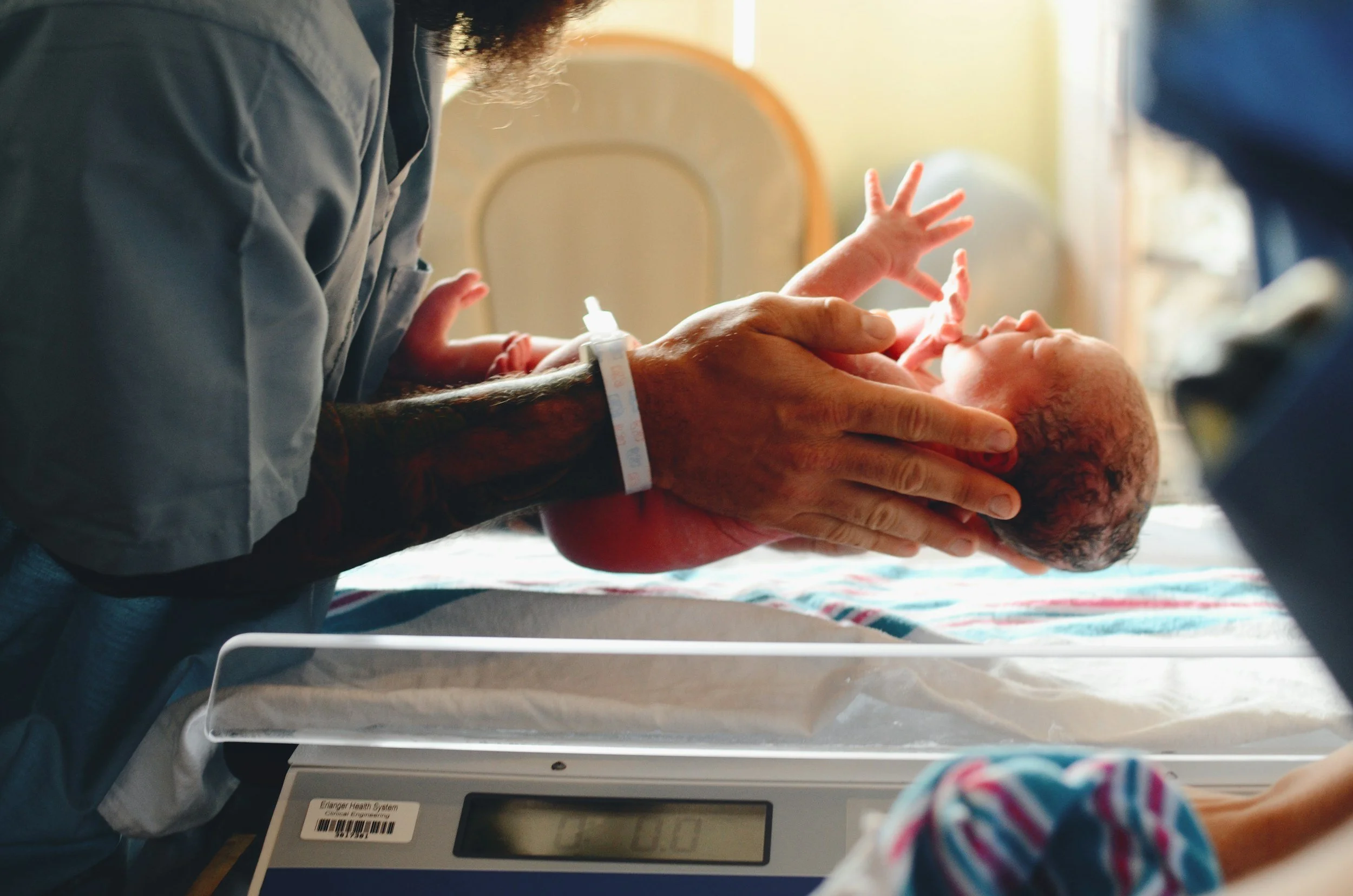Birth Choices in Australia: do you really have freedom of choice?
When I had my first baby, I thought I was making an informed choice. I birthed in a private hospital where I was well-supported, and I’m so grateful for my healthy child. But looking back, I know I was only aware of a fraction of the options available to me. It wasn't until I was pregnant with my second that my journey led me down a completely different path - one that felt radically different from my first.
This experience ignited a passion in me to ensure that every pregnant person understands all their options, because without that knowledge, there is no real freedom of choice. I am not here to tell you what to choose - only you can decide what feels right for you and your family. My goal is simply to illuminate the path and show you the full landscape of possibilities.
In my own journey, I went from a hospital birth with obstetric care to a birth outside the system with a private midwife. For my first birth, I didn't even know homebirth was a possibility, and for that reason, I wasn't able to select the option that would have provided me with the most autonomy.
There are many resources out there that compare the costs and logistics of different perinatal care options, but few provide information around the level of autonomy you will experience in these varying models of care. Many parents-to-be are unaware that the level of agency they will have in their birth will be heavily influenced by the care type that they choose.
What is autonomy?
Autonomy is the right to make your own decisions and to be the ultimate authority over your body, your baby and your care. In Australia, you have a legal right to this in childbirth. This includes the right to decline medical advice or treatment.
It's important to remember that not everyone wants full autonomy (which comes hand in hand with greater personal responsibility), and for some, medical conditions for themselves or their baby mean that certain options are not medically safe. The real issue is when people don't know all the options, so they can't choose the one that is truly best for them and their circumstances.
Let's explore the main birth options in Australia and how autonomy, continuity of care, and cost play out for each.
Freebirth
No registered health professional
A freebirth is when you make a conscious choice to give birth without the support of a registered health professional, like a midwife or doctor.
Autonomy and Continuity of Care: In this model, your autonomy is complete - you are the sole decision-maker. There is no externally affiliated care provider. Some people choose to have a doula or a traditional midwife as a companion before, during and/or after freebirth.
Cost: There are no costs associated with a freebirth itself, though you may incur expenses if you hire a doula or traditional midwife. You will also need to consider the cost of equipment such as a birth pool and oxygen, as well as any training courses you may wish to take such as infant resuscitation.
Limitations: While many people find this empowering, it's important to be aware that there is no medical care or professional support available if a complication arises for you or your baby. In the event of a medical issue, you would need to arrange to transfer to a hospital.
Homebirth
Private Midwife or Community Program
This option involves giving birth at home with the support of a privately practising, endorsed midwife or through a Community Midwifery Program (CMP).
Autonomy and Continuity of Care:
Privately Practising Midwife: This model is often referred to as the "gold standard" for healthy pregnancies because it offers true midwifery continuity of care. With a private midwife, you build a deep, trusting relationship with one person who provides all your antenatal and postnatal care and is present for your birth. This relationship is founded on partnership, which is vital for informed decision-making and genuine autonomy.
Community Midwifery Program: you are typically cared for by a small, known group or 'pool' of midwives, rather than a single individual. This model still provides a high degree of continuity and allows you the option of homebirth, but because the program is run through a public hospital, you are still under their policies and guidelines.
Cost: The cost for a homebirth with a private midwife typically ranges from $5,000 to $8,000. This includes all your antenatal and postnatal care. Some private health insurers offer a rebate, and Medicare rebates are available for a portion of the antenatal and postnatal appointments, but not for the birth itself (at this stage - there is hope that this may change in the next few years). You may also have additional costs for things like ambulance cover or birthing pool hire. Community Midwifery Programs, being part of the public system, are covered by Medicare and have no out-of-pocket costs.
Limitations: Homebirth is generally available for pregnancies without significant medical complications or considerations. If something arises, you may need to transfer to a hospital. The positive is that your midwife can accompany you to the hospital to continue to be part of your care. Some private midwives also have ‘admitting rights’ and can continue to act as your primary care provider within the hospital - it’s worth checking whether this is the case for any midwife you are considering hiring, if that’s important to you.
Birth Centre
Public or Private Options
For those with ‘uncomplicated pregnancies', a birth centre can offer a homely feel and less medicalised approach to birth. They are often run by midwives.
Autonomy and Continuity of Care: In a birth centre, you will typically receive continuity of care from a small group of midwives who get to know you during your pregnancy. This can help you feel more comfortable and trusting of your care providers. Birth centres operate with the belief that for many, pregnancy and birth are normal life events. They offer a more relaxed atmosphere with fewer medical interventions than a hospital.
Types of Birth Centres:
Public Birth Centres: Most birth centres in Australia are attached to a public hospital, or very close to one. This means you can be easily transferred to the hospital if you or your baby need more medical care. While they offer a more relaxed atmosphere, you are still within the hospital system and its rules. These are generally covered by Medicare.
Private Birth Centres: These are much rarer and generally operate by subcontracting private midwives. They offer a private, out-of-hospital birth option, but they are not as common.
Cost: For birth centres that are publicly funded, the cost is usually covered by Medicare, whereas private birth centres may have a fee more similar to hiring a private midwife.
Public Hospital
Staff Midwives and Obstetricians
This is the most common model of care in Australia, where your care is provided by a rostered team of midwives and doctors at a public hospital.
Autonomy and Continuity of Care: In this model, you don't have a single allocated caregiver. You'll see a different midwife or doctor at each antenatal appointment, and likely a new team when you're in labour. While you can have a birth plan, a lack of continuity can make it harder for your preferences to be consistently supported.
Midwifery continuity of care models, where a single midwife or a small team cares for you throughout your pregnancy, birth, and early parenting, are considered the "gold standard" of maternity care. While these models are available in the public system, they are not widely accessible.
Cost: Public hospital care is free for all Australian citizens and permanent residents, as it's covered by Medicare. There are typically no out-of-pocket costs for your antenatal appointments, labour, birth, or hospital stay. This makes it a financially accessible option for everyone. You may still have some costs for things like ultrasounds, blood tests, or medications, but Medicare rebates are often available for these.
Limitations: Public hospitals are well-equipped to manage medical complexities and emergencies. However, care is subject to hospital policies and routines which can impact your autonomy. Research suggests that some maternity care providers have a poor understanding of a pregnant person's legal right to autonomy, particularly when the safety of the baby is perceived to be in question.
Private Hospital
Your Elected Obstetrician
If you choose to give birth in a private hospital, you'll select a private obstetrician who will manage your pregnancy and birth.
Autonomy and Continuity of Care: This model offers continuity of care with one practitioner throughout your pregnancy, which research shows leads to an increased chance of a positive birth experience. However, your obstetrician might not be the one at your birth, as they may be unavailable and a colleague may need to attend. While you get to build a relationship with your care provider, they are a surgeon, and their training is focused on medical management. Private hospitals often have higher rates of interventions, including caesarean births.
Cost: Even with private health insurance, you will likely face significant out-of-pocket expenses for private obstetrician care. A pregnancy management fee from your obstetrician can be in the realm of $5,000 in Australia. There can also be costs for the hospital stay, anaesthetists, or paediatricians. Without private insurance, the total costs can be upwards of $20,000. It is worth noting that for those with private health insurance, the out-of-pocket expenses for a private obstetrician can be similar to the out-of-pocket costs of a private midwife for a homebirth.
The Role of Other Care Providers
No matter which path you choose, remember there are other incredible professionals who can provide support.
Doulas: A doula is a non-medical support person who offers emotional, physical, and informational support before, during, and after childbirth. They do not provide clinical care or make medical decisions. Their role is to provide evidence-based information and tools to help you have a calm and positive experience, and they can be a powerful advocate for your autonomy.
Traditional Midwives: These are midwives who are not registered with the Australian Health Practitioner Regulation Agency (AHPRA). They often work in a similar way to registered private midwives, offering full-spectrum care. However, they are not regulated, and their services are not covered by Medicare.
Systemic Issues
While Australia offers a range of birth options, there are systemic challenges that can limit a person's ability to exercise true freedom of choice. This is something I am incredibly passionate about speaking out on.
Cost: One of the most significant barriers is cost. For those with private health insurance, there will still be out-of-pocket expenses for a private obstetrician or a private midwife for a homebirth. This creates a vast gap between the publicly funded and privately funded options, making certain choices financially inaccessible for many people.
Medical Classifications: Different care providers will have different levels of ‘risk tolerance, leaving some individuals ineligible for a particular birth option, even if they desire it. This can include people planning a Vaginal Birth After Caesarean (VBAC), those expecting twins, or individuals who have had a previous postpartum haemorrhage, a baby conceived with IVF, along with a multitude of other factors. These classifications, while intended for safety, can limit autonomy and access to certain models of care.
Logistical Challenges: People in regional and remote locations face significant logistical hurdles. Access to private midwives, birth centres, and even some public hospital programs can be severely limited or non-existent, forcing many to travel long distances or settle for options they would not have otherwise chosen.
Ultimately, the choice of where and with whom you birth is a deeply personal one. My wish is that you feel empowered to gather all the information and support you need to make the best decision for you, your baby, and your family. The most important thing is to understand what level of autonomy you wish to have in your pregnancy and birth experience, weighed against what is logistically and financially accessible for you. It is my heartfelt hope that Australia and other countries will continue to work towards real freedom of choice by addressing the current financial and logistical limitations that exist.
References:
Nurtured Birth. (2025). Human Rights In Childbirth - What You Need To Know. Retrieved from https://nurturedbirth.com.au/human-rights-in-childbirth/
Queensland Health. (2025). Midwives and doulas - Supporting healthy pregnancies. Retrieved from https://www.pregnancycare.health.qld.gov.au/midwifes-and-doulas
Australian Birth Stories. (2025). What is a Doula and how can you hire one? Retrieved from https://australianbirthstories.com/pregnancy/what-is-a-doula/
Pregnancy, Birth and Baby. (2025). What to expect if I have my baby at a birthing centre. Retrieved from https://www.pregnancybirthbaby.org.au/having-a-baby-at-a-birthing-centre
Kin Fertility. (2025). Public vs Private Hospitals: How Much It Costs to Give Birth in Australia. Retrieved from https://kinfertility.com.au/blog/how-much-does-it-cost-to-give-birth-in-australia
Safer Care Victoria. (2025). Freebirth - Position statement. Retrieved from https://www.safercare.vic.gov.au/best-practice-improvement/clinical-guidance/maternity/freebirth-statement
Homebirth Australia. (2025). Rights & Responsibilities. Retrieved from https://www.homebirthaustralia.org/rights--responsibilities.html
The Australian Preterm Birth Prevention Alliance. (2025). Midwifery Continuity of Care. Retrieved from https://pretermalliance.com.au/alliance-news/latest-news/midwifery-continuity-of-care/
Pregnancy, Birth and Baby. (2025). What is midwife continuity of care? Retrieved from https://www.pregnancybirthbaby.org.au/what-is-midwife-continuity-of-care





